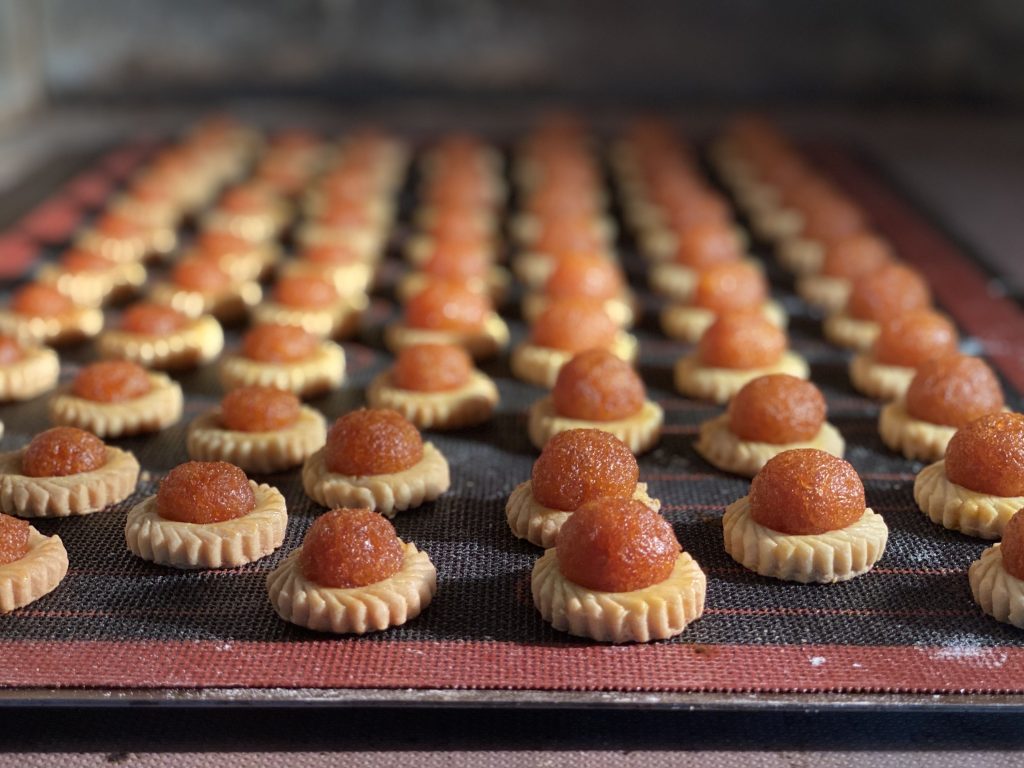If you have any Singaporean, Malaysian, or Indonesian friends and have ever celebrated Chinese New Year with them, then you probably had the good fortune to taste a pineapple tart. If you haven’t, well you’re in for a treat!

Firstly, forget the image of canned pineapples with a custard cream filling in a tart base, the southeast Asian pineapple tart is a thing of beauty in the form of an open-faced flower-shaped pastry, topped with a dollop of pineapple jam purée. Its origins are as rich and convoluted as the race credited with its creation – the Nyonya, the interracial descendants of Hokkien immigrants who raised their families in Southeast Asia.

To add to the confusion of pineapple-related pastries, there exists a Taiwanese version, 凤梨酥 ((Fèng Lí Sū) which should be more accurately called pineapple cake, while the Southeast Asian version translates into 黄梨饼 (Huáng Lí Bǐng). Both do use pineapple jam purée but the main telling difference is that the original Taiwanese Pineapple Cake filling was not purely pineapple but mixed with a considerable amount of cooked winter melon purée. This resulted in the Pineapple Cake becoming sweeter, softer, and less chewy compared to its Southeast Asian counterpart. Another difference in the pineapple filling is that it is cooked together with maltose and does not contain any spices in the filling, so it lacks that tangy taste that the Southeast Asian pineapple tarts offer.

According to food writer Chloee Lee, “The tart finds its origins far back in the 1500s when the Portuguese Empire conquered the Malay Peninsula, notably Malacca during their 130-year colonization period. Incorporating salt into dough, by rubbing butter into flour, was a unique Portuguese way of making pastries, which was adopted by the Peranakan Nyonyas in their dough-making process. Eventually, they incorporated this method into their homemade pineapple jam which was made due to an abundance of domestic pineapple production under the hot tropical climate in the Straits of Malacca, and thus the original pineapple tarts were first invented. As a result of this technology transfer, our tarts have become buttery and crumbly in texture, with undertones of savoriness due to the addition of salted butter into the dough.

Today, pineapple tarts are almost exclusively found during the Chinese New Year as people tend to consume it for its symbolism of auspiciousness and prosperity in the new year ahead. This is also because the Hokkien word for pineapple is ‘Ong Lai’ (huáng lí, 黄梨) which is a homophone for (wàng lái, 旺来), roughly translated to “the arrival of wealth and luck”.”

When I first started writing this article, I wanted to share my cousin’s recipe for incredible homemade pineapple tarts, which is one of the core products in her baking business.
But after discovering how tedious and painstaking the entire process of making pineapple tarts from scratch is, plus the fact that she wouldn’t reveal her secret ingredient, I managed instead to find a source of equally amazing pineapple tarts right here in Beijing. That is none other than fusion restaurant Mulu, owned and operated by a Malaysian family. When the fruit is in season, they can offer a jar of the Southeast Asian pineapple tarts, about 25 pieces, at RMB 168 before shipping. Contact ilovemulu or ilovemulu2 on WeChat to place an order!
For more family-friendly dining recommendations, add TBJButler on WeChat and request to join the FamFriendlyEats WeChat group.
KEEP READING: Jacopo Bruni’s Secret Cookie Recipe Will Deliver All the Comforts of Home
Images: Pexels, Mulu




